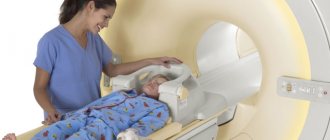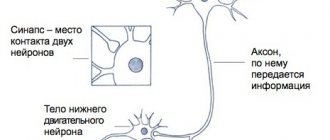Opticomyelitis (Devic's disease)
Opticomyelitis (Devic's disease)
Devic's neuromyelitis optica (neuromyelitis optica, Devic's disease/syndrome) is a neurodegenerative process of an autoimmune nature, accompanied by the destruction of myelin sheaths.
Thus, this is one of the demyelinating diseases of the nervous system (more detailed information about pathology of this kind can also be found in the materials “Multiple sclerosis”, “Guillain-Barré syndrome”, “Subcortical atherosclerotic encephalopathy (Binswanger disease)”). Eugene Devic (France) was a practicing neurologist and researcher; His main publications concerned infantile chorea, cerebral glioma, tumors of the corpus callosum, and typhoid fever. In 1894, E. Devic, in collaboration with his graduate student Fernand Go, described a rare disease of the nervous system (by that time, only 16 cases were known in Europe and North America, to which Devic and Go added their own, seventeenth observation), in many ways similar to multiple sclerosis, but with a distinct specificity, namely almost isolated damage to the optic nerve and spinal cord; Such selectivity is not typical for demyelinating diseases.
It should be noted that descriptions of individual symptoms of neuromyelitis optica appeared long before the work of Devika-Go, back at the beginning of the 19th century. The outstanding English doctor and public figure, Sir Thomas Clifford Allbot, also contributed in 1870 and attracted the attention of the medical community to this specific disorder, but a detailed clinical description of neuromyelitis optica as a separate, independent disease belongs to E. Devic.
Throughout the twentieth century, despite a number of distinctive features, Devic's opticomyelitis was considered one of the atypically severe variants of multiple sclerosis, and some sources stubbornly continue to reproduce this hopelessly outdated interpretation. In the 2000s, mainly through the work of the research sector of the world-famous Mayo Clinic (Rochester, USA), this uncertainty was finally eliminated: it was possible to identify a humoral mechanism that is aggressive towards perivascular protein, and to find reliable biochemical markers of neuromyelitis optica (immunoglobulin antibodies), which do not occur in multiple sclerosis. According to the Mayo Clinic, this was the first time a specific molecular target for the autoimmune-inflammatory demyelinating process had been discovered. As of today, the presence of six types of antibodies is assumed, three of which have already been discovered.
Thus, Devic's neuromyelitis optica is indeed an independent nosological entity, and not a variant of multiple sclerosis.
Epidemiological estimates are difficult due to the relative rarity of this syndrome and the likely occurrence of numerous diagnostic errors. It is reported that "true" Devic's disease occurs approximately fifty times less frequently than classic multiple sclerosis, accounting for 1-2% of the total demyelinating diseases. The age range for initial diagnosis ranges from one year to 77 years; Most often, manifestation occurs in the period of 35-45 years. Women get sick much more often than men (3-9 times according to various sources). Between half and two-thirds of patients with Devic's neuromyelitis optica also have another autoimmune disorder.
Clinical symptoms of Devic's myasthenia
The complicated type is initially characterized by symptoms of blurred vision, pain in the eyes, partial or complete blindness. Signs of transverse myelitis with tetraparesis and paraparesis gradually appear. Weakening the activity of muscle fibers and disruption of muscle innervation are irreversible conditions.
Typical clinical symptoms of neuromyelitis optica:
- One-sided or two-sided blindness;
- Paresis of the muscles of the lower extremities;
- Intestinal dysfunction;
- Atony of the bladder.
The group of changes described is formed over a period of 7-8 weeks. Demyelinating processes are accompanied by significant swelling of brain tissue with hemorrhagic processes and hemorrhages.
Intracerebral hemorrhages are detected by MRI.
Morphological analysis reveals extensive necrotic changes and diffuse transverse spinal myelitis.
The acute form is characterized by an inflammatory process inside the spinal cord. The autoimmune process leads to progression of the clinical picture. Consecutive demyelination causes atrophic changes.
Intraocular changes are detected during ophthalmological examination. Foci of necrosis are extensive and increase over time.
Atypical form of Devic's disease
There are a number of descriptions of pathology associated with an abnormality in the production of antidiuretic hormone. Subsequent clinical studies indicated a possible relationship between BD and pathology. MRI shows more than three hypothalamic lesions in the absence of specific signs of optic nerve or spinal cord necrosis.
The provoking factor of the atypical form is an acute violation of cerebral blood supply. Necrotic foci accompany myelitis. Opticomyelitis, papilledema, respiratory failure, damage to the cervical spine are a consequence of inflammatory changes in the hypothalamic-pituitary zone. Some people have asymptomatic foci of demyelinating encephalomyelitis.
Magnetic resonance imaging helps to differentiate multiple sclerosis, true inflammation of the meninges, and optic nerve necrosis.
Life expectancy in children and adults with neuromyelitis optica
Devic's disease occurs more often in adults. The immune system destroys its own tissues after “antigenic mimicry.” Antibodies are first produced to similar antigens of the pathogen. Then the membrane's own proteins begin to break down. It is impossible to stop the autoimmune process, since the body’s protective environment will destroy “foreign” tissues until complete neutralization.
As long as myelin is present, autoimmune reactions will continue.
The formation of neuromyelitis optica is characterized by the formation of active cells to a specific substance called “aquaporin”. In vitro studies in modern laboratories make it possible to establish a diagnosis of BD with a high degree of reliability.
The life expectancy of an adult is more than ten years. In children, due to increased reactivity, the time period is significantly reduced. If adequate treatment is not carried out, irreversible changes occur in many internal organs, which cause death several years after the onset of the acute form.
Causes
The pathogenesis of the disease is not fully understood. Now it is classified as an autoimmune disease. In 2004, specific NMO-IgG antibodies were identified. They can be found in 65-73% of patients. This makes it possible to differentiate the disease from multiple sclerosis, inflammatory lesions of the central nervous system, and REM. The target for antibodies is the protein channel aquaporin-4. It is predominantly located in the tissues of the spinal cord, in the hypothalamus and periventricularly. Localized in the walls of the blood-brain barrier and in the processes of astrocytes. Therefore, damage to these channels leads to an increase in the permeability of the barrier and the penetration of immune complexes through it. This is how autoimmune inflammation occurs.
With neuromyelitis optica, necrosis of gray and white matter begins. Zones of demyelination appear. The pathology extends to the optic nerves, spinal cord, chiasm and hypothalamus. IgG deposits accumulate perivascularly and in areas of demyelination. Spinal foci of inflammation are represented by atrophy, gliosis and cystic degeneration. Cavities characteristic of syringomyelia may also form. Almost all patients have autoimmune vasculitis.
Diagnostics
Diagnosis of Devic's neuromyelitis optica is a set of measures used to verify a specific disease. Traditionally, the process begins with a history taking, examination and analysis of the patient’s complaints.
The presence of characteristic symptoms manifested by visual disturbances, paresis, and disturbances in physiological functions is evidence in favor of an appropriate diagnosis.
Auxiliary instrumental and laboratory research methods:
- Lumbar puncture with analysis of cerebrospinal fluid (CSF). An increase in the number of cellular elements is observed.
- Magnetic resonance imaging (MRI) of the spine and brain. In the first case, necrotic foci are visualized in the thoracic region. MRI of the brain shows areas of demyelination in the optic tracts. A characteristic feature remains the absence of pathological changes in other structures of the central nervous system.
- Ophthalmoscopy. The ophthalmologist evaluates the fundus of the eye. Pallor and swelling of the optic disc are detected, which is evidence of inflammation.
Determination of specific NMO-IgG antibodies in the patient’s blood is an important additional criterion in the diagnosis of neuromyelitis optica. In 70-85% of patients the test is positive.
Complications
Opticomyelitis is a dangerous disease that can cause death. Death occurs due to the retraction of the cervical segments of the spinal cord into the process with damage to the respiratory center and the development of corresponding insufficiency. The life expectancy of patients depends on the characteristics of the pathology, the selected treatment and the aggressiveness of demyelination.
Possible complications:
- Blindness.
- Paralysis of the lower extremities.
- Persistent dysfunction of the pelvic organs.
Timely initiation of treatment can ensure full recovery of patients.
The use of MRI in the diagnosis of rare forms of multiple sclerosis
In this article we will tell you about MRI diagnostics of the following diseases: 1. Devic's neuromyelitis optica 2. Balo's concentric sclerosis 3. Marburg's disease 4. Diffuse sclerosis (Schilder's leukoencephalitis) 5. Tumor-like MS 6. Inflammatory pseudotumorous demyelination
It is an inflammatory, demyelinating disease of the central nervous system.
It occurs 9 times more often in women, the average age of onset is 39 years, children and the elderly can be affected. It occurs more often in representatives of the yellow race.
After 5 years of illness, more than 50% of patients are blind in one or both eyes or require support when walking.
5-year survival rate – 68%, the main cause of death is neurogenic respiratory failure
Clinical picture of severe bilateral optic neuritis and acute transverse myelitis, developing not simultaneously, but often sequentially over several weeks or months
Extensive areas of demyelination in the cervical spinal cord may extend into the brainstem, causing nausea and neurogenic respiratory failure
Mandatory criteria:
- Optic neuritis;
- Acute myelitis.
Auxiliary criteria (at least 2 out of 3):
An extended lesion in the spinal cord on MRI, measuring 3 or more vertebral segments
Focal changes in the brain that do not meet MRI criteria for multiple sclerosis
Seropositive status for NMO IgG
Acute and rapid progression of symptoms with fatal outcome over weeks or months.
It is observed at the age of 20-50 years. No more than 60 cases have been described; it is more common in the Philippines and China.
Symptoms are caused by damage to the white matter of the cerebral hemispheres. Unlike classical MS, the brainstem, cerebellum, optic chiasm, and spinal cord are not affected.
It manifests itself as signs of increased intracranial pressure, headache, impaired consciousness, seizures, aphasia, and severe cognitive dysfunction.
It is characterized by large concentric plaques in which layers of partially preserved and destroyed myelin alternate in a ring-like manner. The axial cylinders of the axons are intact.
In addition to concentric plaques, there are plaques typical of MS.
Acute demyelinating encephalomyelitis with a malignant course and death within a year.
Young people are predominantly affected.
Manifested by hemiplegia, hemianopsia, aphasia, epileptic seizures, loss of consciousness. Symptoms increase rapidly over a short period of time.
In the cerebrospinal fluid - increased protein levels, slight cytosis or normal. Oligoclonal IgG can be present, but is less common than in MS.
Tumor-like areas of demyelination are characteristic, most often located in the cerebral hemispheres, later in the brain stem and spinal cord. As the disease progresses, unlike ADEM, lesions of different ages are identified.
Histologically, plaques are characterized by extensive demyelination with massive macrophage infiltration, axonal death, severe edema, areas of necrosis, and the presence of hypertrophied giant astrocytes.
A rare form of demyelination that occurs in childhood and requires a careful differential diagnosis (ALD, subacute sclerosing panencephalitis).
It manifests itself as decreased visual acuity or sudden onset blindness, headache, seizures, hemiparesis, aphasia, and vomiting.
It is characterized by extensive areas of demyelination located in the cerebral hemispheres, measuring more than 2-3 cm. There may also be plaques similar to MS.
Histologically, there are extensive areas of demyelination with perivascular macrophage and lymphocytic infiltration. Tissue necrosis with the formation of cysts is possible.
Clinically: acute or subacute onset with general cerebral and focal symptoms.
Radiological: differential diagnosis with glioma, MTS or multiple cysts.
Significant positive dynamics after corticosteroid therapy.
Differential diagnosis of spinal cord lesions in MS should be carried out with intramedullary tumors, ischemic spinal circulatory disorders, lymphoma, HIV myelopathy, syphilis, funicular myelosis, leukodystrophies, post-traumatic and radiation myelopathy.
The specificity of MRI in diagnosing MS reaches 80%, since lesions in the white matter, similar to MS plaques, can be detected both in healthy individuals and in individuals suffering from other neurological diseases. In other words, a reliable diagnosis of multiple sclerosis is carried out in 4 out of 5 diagnostically unclear cases.
Characteristic symptoms of neuromyelitis optica
The clinical picture includes the following manifestations:
Basic for all patients is optic neuritis and myelitis, that is, inflammation of the spinal cord. Moreover, in 80% of cases, myelitis begins within three months from the onset of visual disturbances. And only in 20% of cases does the pathology begin with myelitis, after which optic neuritis is added.- There are a number of cases where Devic's disease was preceded by ARVI, fever and other infections.
- There have been cases where neuromyelitis optica is secondary to such autoimmune pathologies as UC, rheumatoid arthritis, Sjogren's syndrome, SLE, autoimmune thyroiditis, antiphospholipid syndrome, thrombocytopenic purpura.
- Most often, the disease occurs with bilateral damage to the optic nerves. In the early stages, patients experience decreased image clarity. There is a feeling of a veil before the eyes. Subclinical optic neuritis can be diagnosed by ophthalmoscopy. When the acute form of the disease passes, visual function is partially restored, although in some cases, on the contrary, atrophy of the optic nerve may occur, leading to permanent blindness.
- Spinal lesions can be widespread longitudinal, partial or complete transverse in nature. They are accompanied by lower para- or tetraparesis, ataxia, spastic muscle hypertension, autonomic disorders and incoordination in the limbs.
- Sensory disorder is noted below the level of spinal inflammation.
- Pelvic dysfunctions are often observed: urinary retention and fecal incontinence.
- In 35% of patients there is a strong lumbago running in the caudal direction, radiating to the legs - Lhermitte's symptom.
- Crumples may occur in the legs.
- With neuromyelitis optica, spinal disorders extend to at least 2-3 segments of the spine.
- In 85-90% of cases, the pathology has a remitting course, characterized by the presence of acute periods and short remission. In this case, simultaneous manifestations of myelitis and neuritis, or separate attacks, may occur. The time intervals between which range from several months to several years. The monophasic form is accompanied by a progressive course of neuritis and myelitis without periods of remission and relapses.











